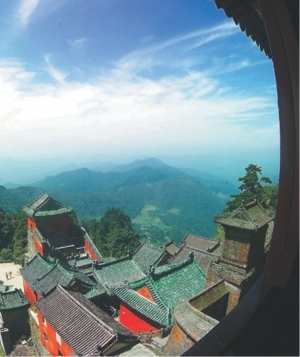| Home - Back Issues - The Team - Contact Us |
 |
| Volume 10 |Issue 30 | August 05, 2011 | |
|
|
Travel Wudang with Panache Wudang is more than just another martial arts Mecca in China, and Fred Yang takes a pilgrimage to savour the scenery and the culture.
Whey say "seeing is believing", and inspired by all those kungfu movies I was weaned on, I decided to experience the fascinating attractions of Wudang Mountain first-hand. From Beijing, it's a two-hour flight to Wuhan, Hubei province, and then a transfer to a rough, uncomfortable four-hour rail journey before I finally stood at the foot of the Wudang Mountain. I checked into a nice hotel that bears the same name and hurried outside to begin my sightseeing. This is a cozy, self-contained community with unassuming architecture. Most buildings are no more than five stories high, and they line the streets with an earthy, refreshing charm. It's a sight that instantly releases the visitor from the cloying, constricting mess that is most metropolitan cities. I was spared the aggravation of taxis and traffic lights because everything was within walking distance. As dusk closed in, the restaurants lining the road began putting out tables outside and started doing a booming business in barbecue. At a small place called Cucha Danfan, or, roughly, "the simple diet", I found the food quite similar to what you'd get in rural Beijing - tasty, reasonably priced, sufficient portions, but with local flair. The next day, having gotten my second wind, I set out for the mountains themselves. My first stop was Golden Palace, the most famous scenic spot on top of Heavenly Pillar Peak. It's a three-hour trek to the top, so I opted for the cable car which cuts the trip to eight minutes.
The ride up gives you a thrilling bird's-eye view of the entire mountain range and it had me up above the clouds before I even knew it. It was then that I realised that those pictures I saw from the movies and the Internet were all real. The sea of clouds did indeed wash across the mountains, bathing them in a misty shroud. The wind set the clouds in motion and created a moving landscape painting against a backdrop of outstretched greenery. Once out of the cable car, several flights of stone steps got me to Heavenly Pillar Peak, which was surrounded by the incense being burned by the faithful. I admired the architecture of the Hall of Turning Fate and Palace of Harmony perched in the mist along the mountain path, each with its own Taoist deities squatting inside, patiently waiting for homage to be paid by worshippers. I recommend a roughly 30-second walk into the Hall of Turning Fate, which has a statue of the Taoist god and a U-shaped passageway that's barely big enough for you to get through. Once you wiggle your way out, legend has it that the turn through the temple would have dispelled all bad luck, and you're a new person. Another thing you'll notice are the countless locks attached to chains underneath the handrail along the mountain road. Most have people's names carved on them to symbolise a love that will last as long as the mountain is around. Finally, after slowly edging my way up the steps of the incredibly narrow path along with the swarm of tourists, I ended up at the Golden Palace. Here, it is all one huge bustling mass of worshippers burning incense, kneeling and praying, drawing oracle sticks, fortune-telling, and picture-taking. The Golden Palace is surrounded by dozens of copper pillars, and visitors had rubbed them until they were all shining, with a patina around the middle. The tour guide said a good rub would bring good fortune. I guess the tourists must all believe that. At the top of Heavenly Pillar, the vantage point gives a panoramic picture of Wudang above the clouds, with the 72 other peaks pressing in or stretching out into the distance. After we finished our visit and got back downhill, we took a bus to Carefree Valley, where we had a chance to frolic with the local monkeys. Some among the group did not look as if they enjoyed the frolicking, especially when some of man's closest relatives got too close, and looked as if they wanted to share the food. Signboards tell tourists that this was where Jackie Chan and Jaden Smith shot some scenes from the film The Karate Kid. As we spiraled our way down the mountain, the many tight twists and turns in the road made some of the group sick. A local told me that according to Taoist lore, this indicated a weakness of the stomach. The next day, I visited the local museum near my hotel, on a new square facing a nice theater. This group of buildings gave the area a modern touch that was a foil for the country surroundings. The two-story museum contains artifacts made from local turquoise, and towering bronze deities. It also has a collection of relics, with videos, soundtracks and illustrations, and a detailed introduction to Taoism and Wudang's Ancient Building Complex, which is on the UNESCO World Cultural Heritage list. Back at the hotel, I ran into two Taoists who were giving a class out on the patio. One of the students was waving a sword, the other practicing taichi, both of them showing a great deal of panache. One of the Taoists said there's been a surge in the number of foreigners coming here to study kungfu. Coming to Wudang is an encounter with nature. The stupendous mountains and spectacular sites, each steeped in its own rich history, make the trip more than worthwhile. For those who love hiking, the mountains also offer hours of traipsing about in the midst of lush forests, reinforcing the oneness of man and nature.
Copyright
(R) thedailystar.net 2011 |

